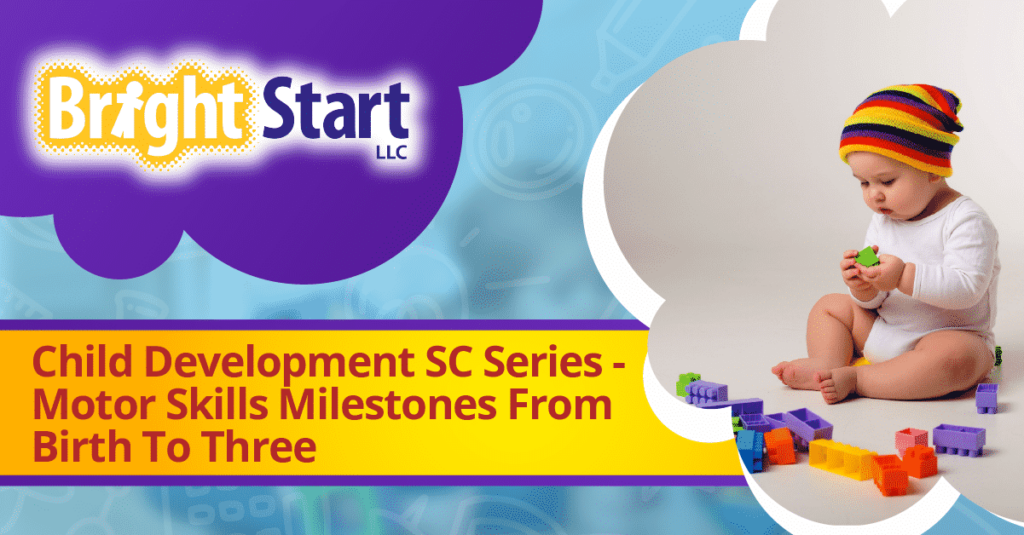
Healthy fine and gross motor skill development is the foundation for your child’s independence, facilitating cognitive, language, and emotional development. Gross motor skills refer to large muscle groups, used when walking, pulling, or doing tummy time. Fine motor skills are those associated with smaller muscles, like those in your child’s hands. Scribbling with markers and playing with toys are some of the ways that babies and toddlers develop these muscles, while running, crawling, and climbing develop their gross motor skills. In this article, you’ll learn about the important motor skills milestones from birth to age three, including ways to help your child meet them.
Tummy Time!
Your baby might not want to lie on their stomach first, especially in their first two months of life, because their neck muscles aren’t very strong yet. These are exactly the muscles that need exercising at this age, however, so it’s important to give them tummy time, even if they resist at first. By two months, your baby should be able to push up from their stomach and hold their head up, perhaps with a little wobbling. Their ability to suck will improve as well, making latching while breastfeeding and bottle-feeding easier for baby and parent.
At four months, after all that tummy time, your baby will hold their head steady without help and will push up to their elbows when on their stomach. Your baby will also begin to turn onto their side, preparing to sit up. Try preparing them for sitting on their own by supporting their back and guiding them from lying down to sitting up. This will get your baby used to the muscle movements they’ll soon be using frequently. For now, your baby will hold and shake toys, bring their hands to their mouth, and demonstrate more purposeful movements.
Crawling, Climbing, and Cruising
By six months old your baby will roll in both directions. This is a great time to practice standing with your child—hold their hands and watch as they support their own weight with just a little help. Your baby will start to explore their crib with all kinds of new movements, from bouncing on their mattress, sitting with minimal support, and rocking back and forth in their crawl position, preparing to take off and explore new things. You can expect your baby to crawl by nine months, accompanied by several other independent movements. They’ll pull themselves up to standing, and will stand on their own with support. They’ll be able to get into the sitting position and can sit up without support.
Soon after, at twelve months, comes the furniture cruising and crib escapes, as their mobility improves. They become little climbers who can sit all on their own. Your baby may stand on their own or even take their first steps, after practicing walking while supporting themselves on furniture. Not all babies are walking by one year, however, and this is nothing to worry about. By eighteen months, however, your baby should be walking on their own with some mastery, pulling or carrying toys as they go. Their fine motor skills will begin to develop at a quick pace now, as they take things apart or build with blocks. You can also expect a lot of climbing on furniture.
Playdates at the Park
When your baby becomes a toddler at two years old, playing becomes more intricate and physical, as they use gross motor skills to run, stand on tiptoe, kick a ball, and throw overhand, becoming even more adventurous climbers as they do. They’ll also be able to use the stairs with alternating feet, so it’s the perfect age for frequent park trips. Couple these more physical playtimes with quieter crafting and art projects, encouraging fine motor development. They’ll be able to draw a straight line and string beads on a string. They might also enjoy trying ride-on toys, like a tricycle. At twenty-seven months, your child will be able to use ride-on toys with relative ease and will also enjoy push and pull toys. Fine motor skills only improve—it’s the perfect time to encourage your toddler to button and zip their own clothes. They’ll also enjoy simple puzzles with knobs and will be able to string buttons on a string.
At thirty months your baby will be able to walk up and down stairs, so you can watch them get up to the slide at the park all on their own. They’ll also kick and throw a ball and build towers of blocks. By thirty-three months your child will run and stop without tripping, avoiding obstacles as they go. The park will become their favorite place to visit, as they enjoy swinging, climbing, sliding, and pedaling a tricycle. They’ll also begin to play sports, as they can now catch a ball and kick a ball forward.
A Little Extra Help
When your child turns three, they’ll be so excited about all they can do. They’ll jump with both feet on the ground, pedal their tricycle, and climb and run easily. They will also be able to build a tower with nine blocks or more and copy a circle when drawing. Each of these motor skills will help them engage, discover, and learn. Your child works on their motor skills everyday just by going about their routine, helping you set the table, playing with siblings, or following you throughout the house. Sometimes, however, especially when babies are new, they need a little extra help to ensure that they’re moving and strengthening their muscles so that they can discover, make new friends, and engage with their world. Our highly trained and dedicated Early Interventionists will meet with you to discuss your family routines and work with you to develop a plan that takes into account all of your child’s unique needs. Together your EI and you will decide on activities that will help foster your child’s healthy motor development. If you feel that your child might need a little extra help to meet these milestones, don’t hesitate to reach out to your doctor, who can put you in contact with us.
